Crafting the Best Digital Transformation Strategy for Your Business
A digital transformation strategy helps businesses integrate digital technologies, reshaping operations and customer experiences. This guide will explain what a digital transformation strategy is, why it’s vital, and how to create one that supports your goals.
Key Takeaways
-
Digital transformation is crucial for businesses to enhance operations, improve customer relationships, and remain competitive in a rapidly changing environment.
-
Successful digital transformation strategies require alignment with business objectives, effective technology integration, and robust change management to facilitate organizational adaptation.
-
Common challenges such as resistance to change, legacy systems, and budget constraints must be addressed through strategic planning and clear performance metrics to ensure successful digital initiatives.
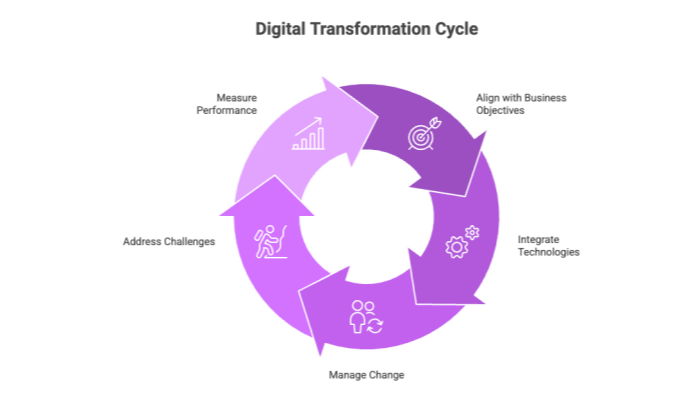

Understanding Digital Transformation Strategy
In the digital age, digital transformation is the integration of digital technology into all areas of business, fundamentally changing how you operate and deliver value to customers. This is not just about upgrading your IT systems; it’s about rethinking your entire business strategy to improve customer relationships and adapt to ever-changing conditions. A digital transformation strategy is a comprehensive plan that leverages digital solutions to enhance various business operations.
Digital transformation frameworks provide a structured roadmap for navigating the disruptions caused by new technologies. These frameworks align employees and management with their goals, ensuring everyone is on the same page. However, this transformation requires significant investment and changes in organizational conduct to be effective. With pressures from digital-first startups and established organizations embracing transformation, businesses must adapt to remain competitive.
Customer habits and preferences are rapidly changing, making digital transformation a mandatory step for businesses. In today’s competitive landscape, organizations focus on digital transformation strategies to maintain business value and drive growth. Integrating digital technologies and embracing innovation enables companies to enhance their capabilities and embark on a successful transformation journey.
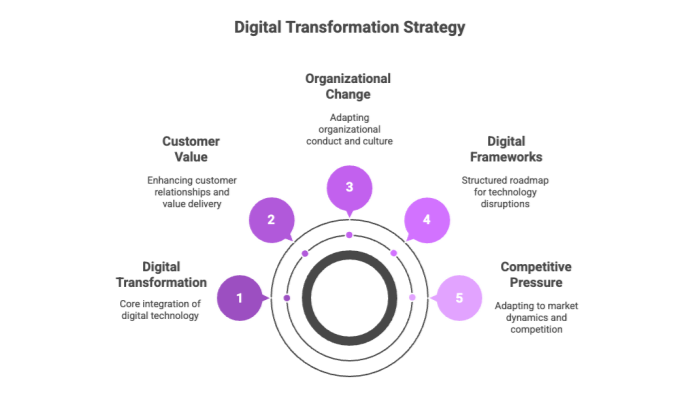

Key Components of a Successful Digital Transformation Strategy
A successful digital transformation strategy is built on three critical elements: aligning with your business vision and objectives, integrating the right technologies, and managing change effectively. These components ensure that your digital transformation initiatives are not just about adopting new tools but about creating meaningful changes that drive your business forward.
Business Vision and Objectives
Aligning digital transformation with your business vision helps achieve strategic objectives. A digital transformation strategy should focus on business outcomes rather than solely on technology. Defined targets influence the efficiency of your digital transformation framework, ensuring that your efforts lead to tangible results.
When creating a digital transformation framework, always keep your objectives in mind. This alignment identifies the value of each project and ensures your transformation strategy progresses your business.
Developing new business models or optimizing many processes requires a clear roadmap to create success.
Technology Integration
Modern technologies enhance operational capabilities and facilitate digital innovation. For example, Under Armour’s shift towards digital transformation involved integrating technology into its products and acquiring fitness tech companies to better connect with customers. This kind of integration not only improves customer experience but also drives business forward in the digital age, showcasing new capabilities.
Human resources play a crucial role in digital transformation, as many employees currently lack the skills needed to keep up with technological advancements. Choosing the right technology must consider industry standards and regulations affecting operations.
Effective technology use transforms business processes and delivered superior services.
Change Management
Successful digital transformation requires:
-
A robust change management strategy to ease the transition.
-
Preparing and training employees, which is a critical aspect that companies should not ignore.
-
Proper team structure and guidance.
Cultural change is emphasized as a crucial part of the digital transformation process. A culture that embraces change ensures sustainable and effective digital transformation initiatives. Cultural change is necessary for a successful digital transformation journey.
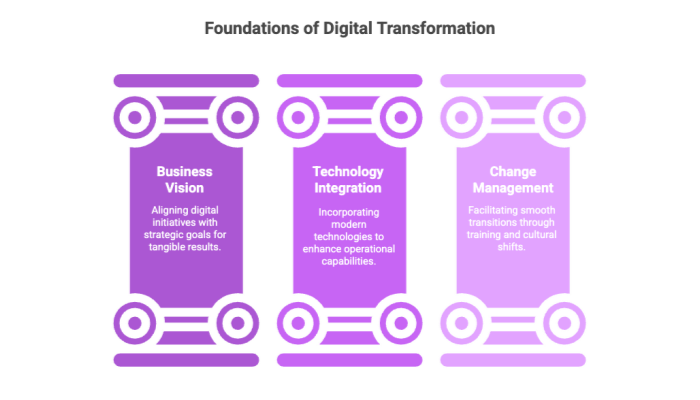

Steps to Develop an Effective Digital Transformation Strategy
Developing an effective digital transformation strategy involves several crucial steps: assessing your current state, setting clear goals, and choosing the right technology. These steps ensure well-planned digital transformation efforts aligned with your business strategy.
Assess Current State
Evaluate the current state of your business processes before initiating the transformation. This assessment should cover:
-
Legislative aspects
-
Market aspects
-
Competitive aspects
-
Regulatory aspects
This will help you understand where your organization stands in its digital transformation journey.
Understanding customer relationships and worth noting identify improvement areas are critical in this initial assessment.
Set Clear Goals
Measurable goals provide a framework for assessing digital transformation effectiveness. Organizations with a solid change management strategy are significantly more likely to achieve their digital transformation goals. Initial digital transformation projects should aim for quick wins to build momentum and demonstrate value.
Understanding long-term goals can help organizations manage spending and prioritize investments more effectively. Setting clear, measurable goals ensures digital transformation efforts align with business outcomes and drive progress.
Choose the Right Technology
Choosing the right technology is crucial for a successful digital transformation. Upgrading legacy applications can lead to better efficiency and reduced operational risks for organizations. However, data transfer delays during cloud migration often result in extended project timelines and potential disruptions.
Leveraging technology with new technologies and digital tools increases efficiency and drives innovation. Selecting the right technology should be aligned with your digital strategy, emerging technology, and transformation goals.
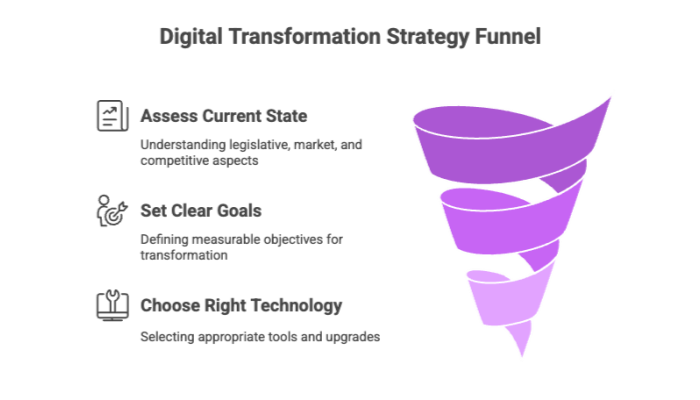

Common Challenges in Digital Transformation and How to Overcome Them
Digital transformation is not without its challenges. Common hurdles include resistance to change, legacy systems, and budget constraints. Understanding and overcoming these challenges is crucial for a successful transform journey.
Resistance to Change
Key factors for successful digital transformation include:
-
Communication of the value of digital transformation successes to encourage employee engagement and mitigate resistance to change.
-
Genuine empathy from leaders to build trust during digital transformation.
-
Comprehensive training and continuous support to facilitate adopting new tools and processes.
Embedding project collaboration into the culture can accelerate transformation. Fostering a culture change creates an environment where effective collaboration supports digital transformation initiatives.
Legacy Systems
Legacy technology hinders the ability to successfully implement a digital transformation strategy. Maintaining legacy systems leads to high operational costs, which limit investment in new opportunities. Organizations facing legacy technology challenges should focus on application modernization. This approach can help them overcome those issues effectively.
Modernizing applications reduces downtime and security incidents, increasing efficiencies.
Budget Constraints
Funding is a significant challenge in digital transformation, as businesses often struggle to secure adequate financing for their projects. Maintaining outdated systems can incur high costs that detract from budget allocations for innovation.
Budget limitations can lead to scope creep, which complicates project timelines and increases costs. Clearly defining project scopes and maintaining strict budget controls helps avoid financial limits.
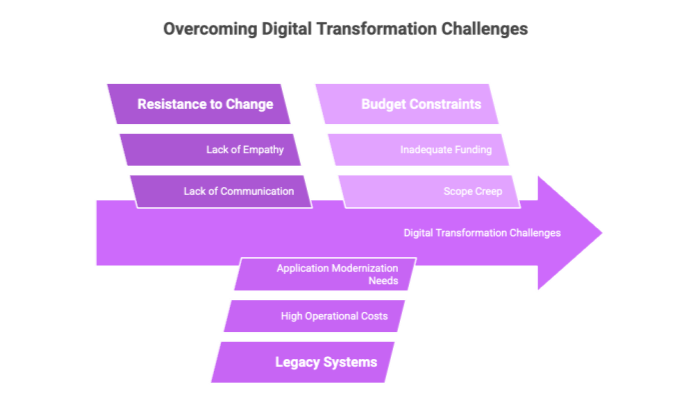

Measuring Success in Digital Transformation
Measuring success in digital transformation requires clear key performance indicators (KPIs) to evaluate project effectiveness. Choosing the right KPIs requires understanding business processes and objectives. Over 70% of digital initiatives fail due to vague objectives and ineffective progress tracking.
There are three main types of KPIs related to digital transformation:
-
Organizational change KPIs: assess the impact of digital initiatives on company structure and culture.
-
Business process KPIs: track the efficiency and quality of internal operations following digital transformation.
-
Customer-focused KPIs: crucial for evaluating the impact of digital changes on client experience.
Employee productivity metrics are essential to determine how digital transformation affects workforce efficiency. Financial KPIs help quantify the monetary return on digital transformation initiatives over time. Project management KPIs ensure that digital transformation projects align with broader organizational goals.
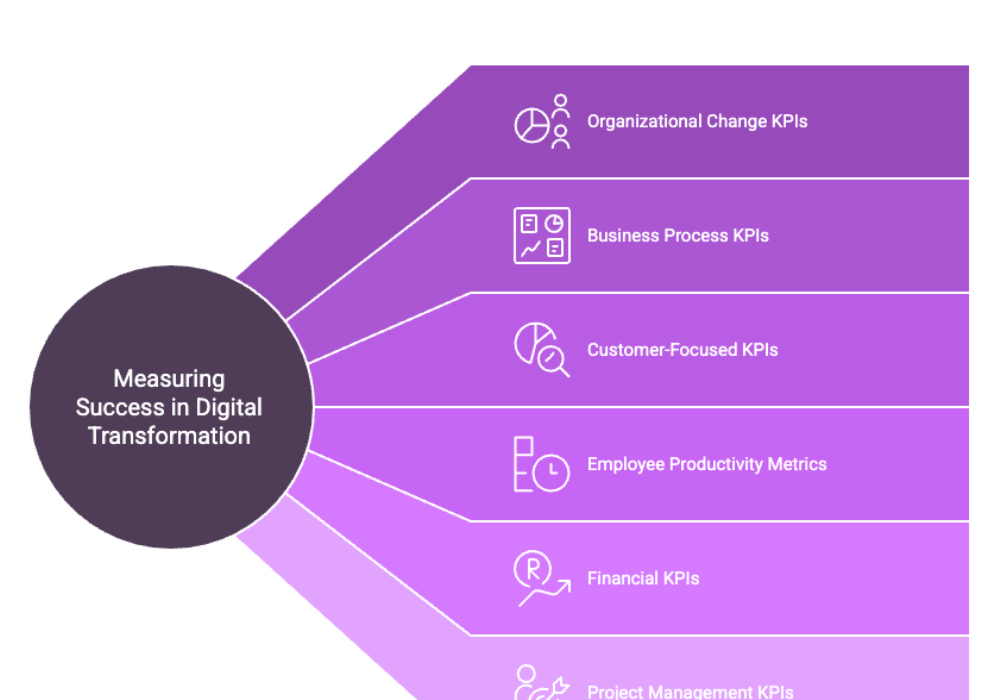

Case Studies of Successful Digital Transformations
Netflix transformed from a DVD rental service to a leading streaming platform, capitalizing on digital technologies to enhance user experience and significantly increase revenue. Amazon evolved from an online bookstore to a dominant global e-commerce giant by adapting to digital customer expectations and enhancing its service offerings.
LEGO utilized digital transformation to restructure its business, optimize processes, and enhance customer engagement, helping it avoid bankruptcy and thrive.
These case studies highlight the critical role of adapting to digital changes, optimizing operations, and enhancing customer engagement to achieve successful transformation outcomes.
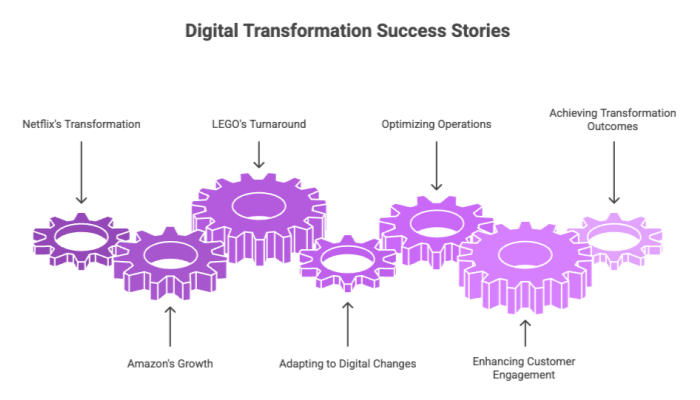

Future Trends in Digital Transformation
Key technology trends and predictions include:
-
The Internet of Things (IoT) is expected to see an increase to 43 billion connected devices by 2023, creating vast opportunities in manufacturing industries.
-
AI and machine learning technologies are anticipated to boost manufacturing productivity by up to 40% by 2035.
-
The rollout of 5G technology is predicted to significantly accelerate advancements in areas like smart cities and IoT applications.
AI helps mitigate the IT skills gap by automating roles traditionally filled by human workers. A noticeable shift from B2B to B2B2C eCommerce allows businesses to offer tailored experiences akin to B2C services, leveraging artificial intelligence.
Key points about the Everything as a Service (XaaS) model and digital transformation include:
-
The XaaS model is expected to dominate as companies prefer third-party cloud solutions over in-house capabilities.
-
Global investment in digital transformation is projected to grow at a rate of 17.1% annually, reaching $2.3 trillion by 2023.
-
Companies will focus on pragmatic approaches, prioritizing strategies aligned with business goals over trendy technologies.
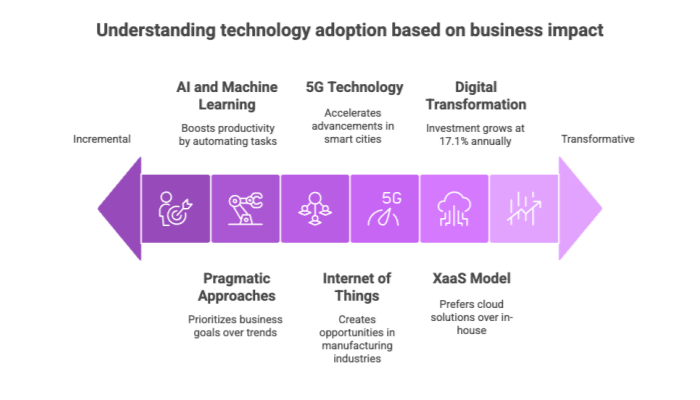

Summary
Digital transformation is a complex but essential journey for any business aiming to stay competitive in the digital age. By aligning your strategy with business objectives, integrating the right technologies, and managing change effectively, you can ensure a successful digital transformation.
Remember, the key to success lies in understanding your current state, setting clear goals, and choosing the right technology. Overcoming common challenges like resistance to change, legacy systems, and budget constraints is crucial. By measuring your success through clear KPIs and learning from successful case studies, you can navigate the future trends in digital transformation confidently.

Frequently Asked Questions
This FAQ section addresses common inquiries related to digital transformation strategy, providing insights into the organization's digital transformation process, key challenges, and success measurement. As many organizations face evolving market pressures and strive for revenue growth, effective digital transformation initiatives require robust internal communication and cross functional collaboration.
Leveraging data analytics and digital capabilities enhances organizational resilience, especially in complex areas like supply chain management. This introduction aims to clarify essential aspects of digital transformation to support business leaders in navigating this time consuming but critical journey.
What is digital transformation?
Digital transformation is the comprehensive integration of digital technology across all business sectors, fundamentally altering operations and enhancing value delivery to customers.
Why is aligning digital transformation with business vision important?
Aligning digital transformation with your business vision is crucial as it ensures that your initiatives drive meaningful results and advance your organization’s objectives. This strategic alignment fosters cohesiveness and maximizes the impact of your transformation efforts.
What are some common challenges in digital transformation?
Common challenges in digital transformation are resistance to change, legacy systems, and budget constraints. Addressing these issues is essential for successful implementation.
How can you measure the success of digital transformation?
You can measure the success of digital transformation by utilizing key performance indicators (KPIs) that evaluate its impact on organizational change, business processes, customer experience, employee productivity, and financial performance. This comprehensive approach ensures that all critical areas of transformation are accounted for.
What are some future trends in digital transformation?
The future of digital transformation will prominently feature the rise of IoT, AI and machine learning, 5G technology, a shift to B2B2C eCommerce, and the adoption of the Everything as a Service (XaaS) model. These trends indicate a significant evolution in how businesses operate and deliver services.

